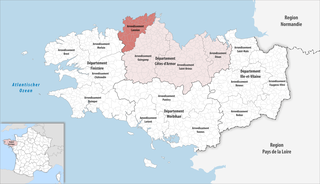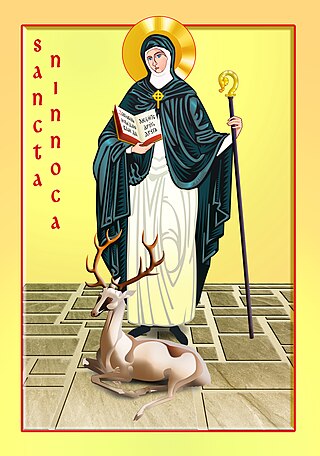
Ys, also spelled Is or Kêr-Is in Breton, and Ville d'Ys in French, is a mythical city on the coast of Brittany that was swallowed up by the ocean. Most versions of the legend place the city in the Baie de Douarnenez.

The arrondissement of Lannion is an arrondissement of France in the Côtes-d'Armor department in the Brittany region. It has 57 communes. Its population is 100,259 (2021), and its area is 904.4 km2 (349.2 sq mi).

The former Breton and French diocese of Tréguier existed in Lower Brittany from about the sixth century, or later, to the French Revolution. Its see was at Tréguier, in the modern department of Côtes-d'Armor.

Tréguier Cathedral is a Roman Catholic church and former cathedral in Tréguier, Côtes-d'Armor, France. It is dedicated to Saint Tudwal. The church was formerly the seat of the Bishopric of Tréguier, abolished under the Concordat of 1801, when its territories were divided between the Diocese of Quimper and the Diocese of Saint-Brieuc, known since 1852 as Saint-Brieuc-Tréguier.

The Chemins de fer départementaux du Finistère were a metre gauge railway system in northwest Brittany, France. It was opened in stages between 1893 and 1907, and closed in 1946. The system had a total extent of 214 kilometres (133 mi).

The Chemin de fer des Côtes-du-Nord, the Côtes-d'Armor today, was a 1,000 mm, metre gauge, railway in Côtes-du-Nord, France, although there were a few kilometres of line in Finistère and Ille-et-Vilaine. The first lines opened in 1905 and final closure was in 1956. The lines were a voie ferrée d'intérêt local system with a total extent of 457 kilometres (284 mi).

Arthur Le Moyne de La Borderie, was a Breton historian, regarded as a father of Brittany's historiography.

Yves Hernot is the name of two sculptors, father and son, who ran the Ateliers Yves Hernot sculpture workshop in Lannion, Brittany, which specialised in creating Calvaries and tombs.

According to late traditions, Clair was the first bishop of Nantes, France in the late 3rd century. He is venerated as a saint in the Catholic Church.

Saint Goulven de Léon was a saint in Brittany in the 6th-7th century. Any knowledge of his life is derived from his vita, of which only a copy of a transcription of the original remains and whose historical accuracy is in question. According to that vita, he was the bishop of Saint-Pol-de-Léon in the seventh century, after having acquired a reputation as an ascetic and anchorite whose prayer and presence cured people and had helped fight off a Viking invasion. When he was elected as bishop, he tried to avoid that responsibility by going to Rome; after intervention by Pope Gregory I he returned and served for over a decade. He died in Rennes, where he was buried in the cathedral. He continued to be venerated in various parts of Brittany, most notably in the small commune of Goulven and other communes nearby in the Pays de Léon, the very western part of Finistère.
Albert Le Grand was a Breton hagiographer and a Dominican brother.

Saint Arnoc or Ernoc or Arnec or Théarnec or Thernoc or Ternoc was a Breton saint from early Armorica. He is the patron of the parish of Trégarantec in Finistère.

Saint Ruelin succeeded Saint Tudwal as Bishop of Tréguier. He died ca. 650. His fest is February 28.
Saint Pergat or Pergad or Pergobat or Bergat was a sixth-century Brenton bishop contemporary with Saint Ruelin. He is regarded as a saint in local Brenton calendars: His feast day is August 1st or August 3rd.

Saint Yban, also known as Saint Ethbin, saint Iboan, saint Diboan, saint Diboen, saint Iben, saint Ibe, saint Abibon, saint Languis, saint Langui, saint Idunet, saint Ivinec, is one of a number of semi-legendary Breton saints from Armorica who are recognized by the Catholic Church. He was a disciple of Saint Winwaloe. He founded a priory which is today the city of Châteaulin.
Saint Urfol is a Breton saint from Armorica. His Feast Day is September 17.

Saint Ninnoc or Ninnog of Breton, also known as Nenooc, Nennoca, Nennocha, Ninnoc, Ninnocha, and Gwengustle, was an early medieval abbess born in Wales who died in Brittany. The text of Vita Sanctae Ninnocae, preserved in the Cartulary of Quimperlé, provides knowledge of her life and work.

Saint Pompeia, also known as Aspasia, is a legendary Breton saint who supposedly lived in the 6th century. Her feast day is celebrated on 2 January.

The presence of horses in Breton culture is reflected in the strong historical attachment of the Bretons to this animal, and in religious and secular traditions, sometimes seen from the outside as part of local folklore. Probably revered since ancient times, the horse is the subject of rites, witchcraft, proverbs and numerous superstitions, sometimes involving other animals.


















